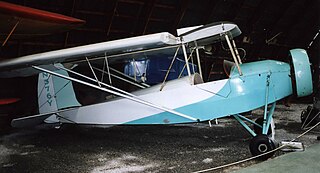Related Research Articles

The Cessna 120,140, and 140A, are single-engine, two-seat, conventional landing gear (tailwheel), light general aviation aircraft that were first produced in 1946, immediately following the end of World War II. Production ended in 1951, and was succeeded in 1959 by the Cessna 150, a similar two-seat trainer which introduced tricycle gear. Combined production of the 120, 140, and 140A was 7,664 units in five years.
The SJ-1 Head Skinner was a single-seat, gull-wing sports plane built in the US by brothers Earl and Jerry Adkisson of Tuscola, Illinois in 1957.

The RA-14 Loisirs was a French two-seat high-wing light touring aircraft designed by Roger Adam shortly after World War II.

The Aerosport Woody Pusher is a two-seat parasol wing monoplane designed for home building by Harris Woods, based closely on the Curtiss Junior. First marketed in the 1960s, at least 27 were flying by 1980.
The Anderson EA-1 Kingfisher is a US two-seat amphibious aircraft designed and marketed for homebuilding. It was the work of Earl William Anderson, a Pan Am airline captain, who flew the prototype on 24 April 1969. By 1978, 200 sets of kits for the plane had been sold, and 100 Kingfishers were reported to be under construction. The aircraft is a shoulder-wing monoplane with a flying boat hull and outrigger pontoons. On land, it uses retractable tailwheel undercarriage. The single engine with a tractor propeller is mounted in a nacelle above the wing. Some builders utilize the wings from a Piper Cub rather than making their own.

The Piper PA-36 Pawnee Brave is a 1970s American single-engined, low-wing, propeller-driven agricultural plane built by Piper Aircraft.
The Piper PA-6 Sky Sedan was a 1940s American four-seat light aircraft designed and built in prototype form by Piper Aircraft at its Lock Haven, Pennsylvania, factory.

The Bullet Monoplane or Alexander Eaglerock Bullet was a low wing cabin monoplane that was a departure from traditional biplane aircraft of the era.
The Renard R.30 was a prototype trimotor airliner built in Belgium in 1931. It was a strut-braced high-wing monoplane of conventional design with a fully enclosed flight deck and separate passenger compartment. One engine was mounted on the nose, while the other two were mounted on the leading edges of the wings. Construction was metal throughout, skinned in plywood and fabric.

The Nicolas-Beazley NB-8G is a United States two-seat parasol wing light monoplane that was constructed in the early 1930s.

The Fisher Celebrity is a Canadian two-seat, conventional landing gear, single engined, biplane kit aircraft designed for construction by amateur builders. Fisher Flying Products was originally based in Edgeley, North Dakota, United States but the company is now located in Dorchester, Ontario, Canada.

The Aeroprakt A-26 Vulcan is a light twin engine aircraft developed from a modified Aeroprakt A-20 light single aircraft. Some models imported to the United States are registered as Spectrum Aircraft SA-26 Vulcan.

The Aeromarine 50, also called the Limousine Flying Boat, was a luxury seaplane.

The Mainair Blade is a British ultralight trike that was designed and produced by Mainair Sports and later P&M Aviation. The aircraft was supplied as a completed aircraft.
The ACE Aircraft Falcon Cabin Coupe was a light, low cost aircraft built during the Great Depression.
The Gobosh 800XP is an American light-sport aircraft marketed by Gobosh Aviation of Moline, Illinois. The 800XP was introduced in 2008 and is supplied as a complete ready-to-fly-aircraft.
The Akaflieg Stuttgart fs28, nicknamed Avispa is a single engine, twin boom pusher configuration light sports and utility aircraft designed at the University of Stuttgart in West Germany in the 1970s. Unusually, it has an inverted V-tail. The sole example remained active as of 2010.

The World Aircraft Spirit is a Colombian/American amateur-built aircraft, designed by Max Tedesco and produced by World Aircraft Company. The aircraft was publicly introduced at AirVenture in 2011 and production is expected to commence in 2014. It is supplied as a kit for amateur construction or as a complete ready-to-fly aircraft.
The American Homebuilts John Doe is an American STOL homebuilt aircraft that was designed by Steve Nusbaum and produced by American Homebuilts of Hebron, Illinois, first flown in 1994. When it was available the aircraft was supplied as a kit for amateur construction.

The Bede BD-12 was an American homebuilt aircraft designed by Jim Bede and produced by Bede Aircraft of Medina, Ohio, introduced in the 1990s. The aircraft was intended to be supplied as a kit for amateur construction, but only one was ever built.
References
- ↑ Popular Aviation: 32. June 1931.CS1 maint: untitled periodical (link)
- ↑ David Mondey. The complete illustrated encyclopedia of the world's aircraft .
- ↑ Popular Aviation: 11. July 1931.CS1 maint: untitled periodical (link)
- ↑ Aerospace Industries Association of America; Manufacturers Aircraft Association; Aeronautical Chamber of Commerce of America (1932). Aircraft year book, Volume 14. American Aviation Publications.
- ↑ Popular Aviation: 35. November 1931.CS1 maint: untitled periodical (link)
- ↑ Popular Aviation: 96. December 1931.CS1 maint: untitled periodical (link)
- ↑ Popular Aviation: 134. December 1931.CS1 maint: untitled periodical (link)